Social Determinants of Health: Impact on Indigenous Communities
VerifiedAdded on 2023/06/11
|7
|2328
|319
Essay
AI Summary
This essay explores the significant impact of social determinants of health on Indigenous communities, highlighting how non-medical factors like income, education, employment, and housing profoundly affect health outcomes. It discusses the health inequities faced by Indigenous populations, particularly in countries like Australia, emphasizing the gap between Indigenous and non-Indigenous health status. The essay examines how these social determinants contribute to poorer health outcomes and reduced access to healthcare, leading to a cycle of disadvantage. Furthermore, it references research and surveys, including those by the World Health Organisation and the Australian Institute of Health and Welfare (AIHW), to quantify the impact of social determinants on health gaps. The analysis reveals that factors such as employment, education levels, housing adequacy, and household income significantly contribute to health disparities between Indigenous and non-Indigenous Australians. The essay concludes by emphasizing the need to address these social determinants to improve the health and well-being of Indigenous populations.

ESSAY
Paraphrase This Document
Need a fresh take? Get an instant paraphrase of this document with our AI Paraphraser
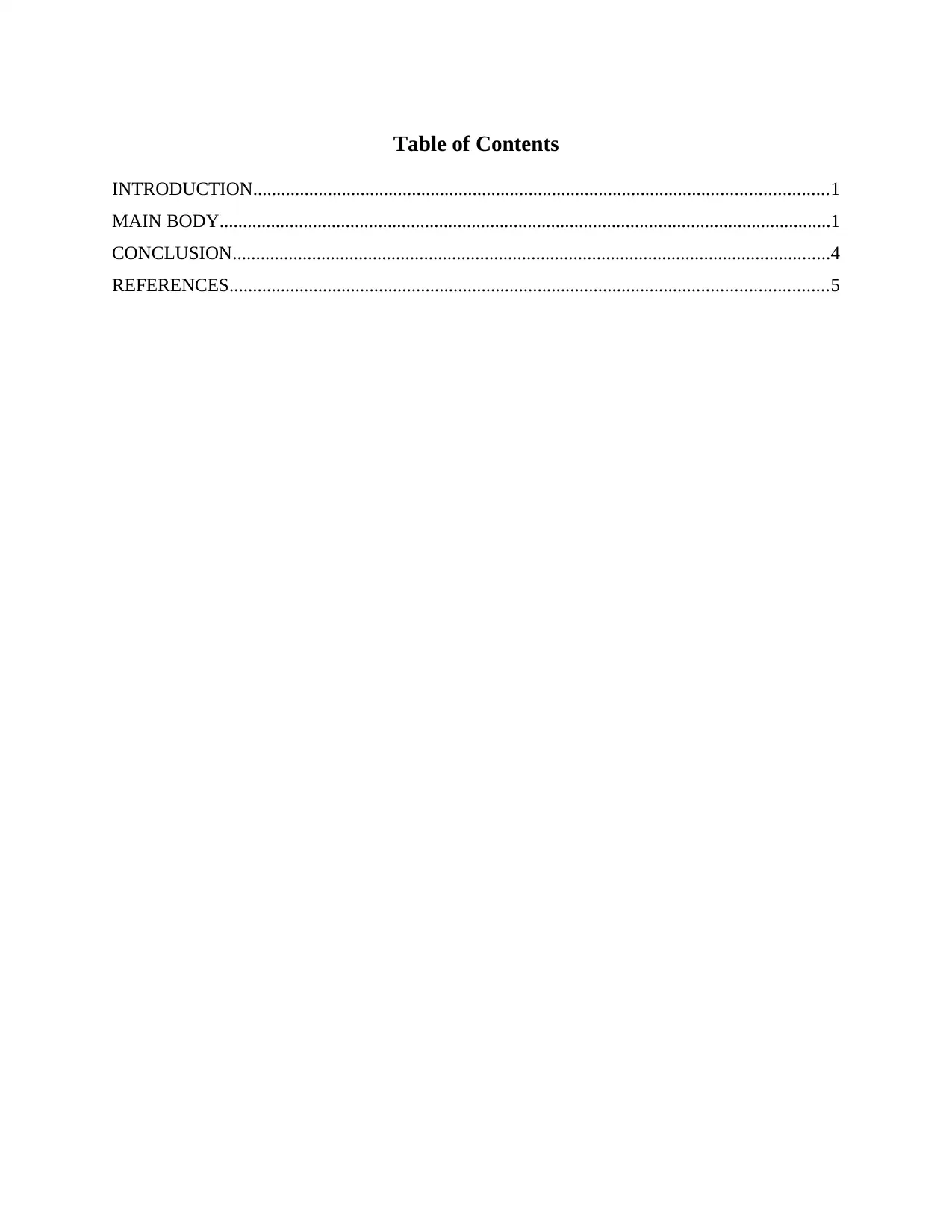
Table of Contents
INTRODUCTION...........................................................................................................................1
MAIN BODY...................................................................................................................................1
CONCLUSION................................................................................................................................4
REFERENCES................................................................................................................................5
INTRODUCTION...........................................................................................................................1
MAIN BODY...................................................................................................................................1
CONCLUSION................................................................................................................................4
REFERENCES................................................................................................................................5
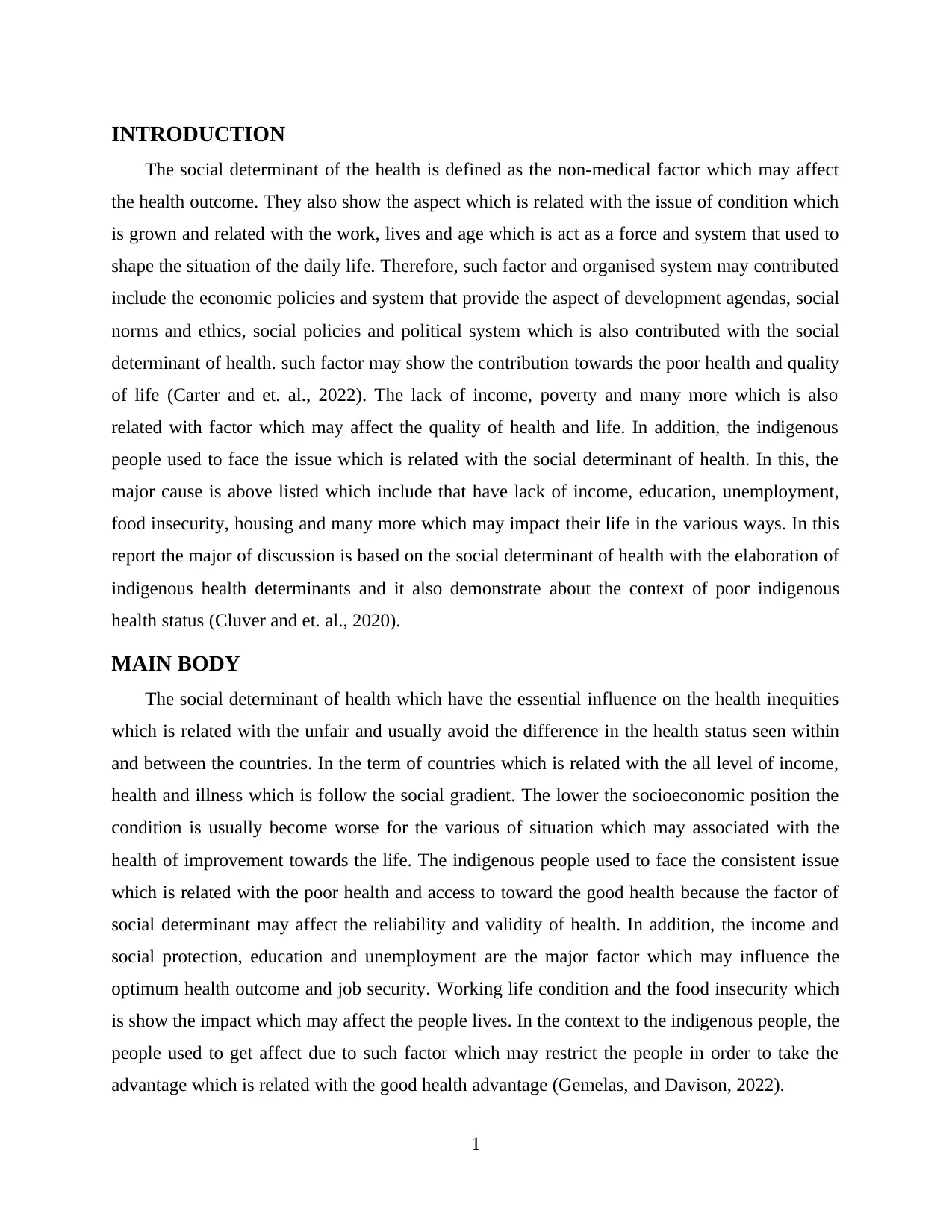
INTRODUCTION
The social determinant of the health is defined as the non-medical factor which may affect
the health outcome. They also show the aspect which is related with the issue of condition which
is grown and related with the work, lives and age which is act as a force and system that used to
shape the situation of the daily life. Therefore, such factor and organised system may contributed
include the economic policies and system that provide the aspect of development agendas, social
norms and ethics, social policies and political system which is also contributed with the social
determinant of health. such factor may show the contribution towards the poor health and quality
of life (Carter and et. al., 2022). The lack of income, poverty and many more which is also
related with factor which may affect the quality of health and life. In addition, the indigenous
people used to face the issue which is related with the social determinant of health. In this, the
major cause is above listed which include that have lack of income, education, unemployment,
food insecurity, housing and many more which may impact their life in the various ways. In this
report the major of discussion is based on the social determinant of health with the elaboration of
indigenous health determinants and it also demonstrate about the context of poor indigenous
health status (Cluver and et. al., 2020).
MAIN BODY
The social determinant of health which have the essential influence on the health inequities
which is related with the unfair and usually avoid the difference in the health status seen within
and between the countries. In the term of countries which is related with the all level of income,
health and illness which is follow the social gradient. The lower the socioeconomic position the
condition is usually become worse for the various of situation which may associated with the
health of improvement towards the life. The indigenous people used to face the consistent issue
which is related with the poor health and access to toward the good health because the factor of
social determinant may affect the reliability and validity of health. In addition, the income and
social protection, education and unemployment are the major factor which may influence the
optimum health outcome and job security. Working life condition and the food insecurity which
is show the impact which may affect the people lives. In the context to the indigenous people, the
people used to get affect due to such factor which may restrict the people in order to take the
advantage which is related with the good health advantage (Gemelas, and Davison, 2022).
1
The social determinant of the health is defined as the non-medical factor which may affect
the health outcome. They also show the aspect which is related with the issue of condition which
is grown and related with the work, lives and age which is act as a force and system that used to
shape the situation of the daily life. Therefore, such factor and organised system may contributed
include the economic policies and system that provide the aspect of development agendas, social
norms and ethics, social policies and political system which is also contributed with the social
determinant of health. such factor may show the contribution towards the poor health and quality
of life (Carter and et. al., 2022). The lack of income, poverty and many more which is also
related with factor which may affect the quality of health and life. In addition, the indigenous
people used to face the issue which is related with the social determinant of health. In this, the
major cause is above listed which include that have lack of income, education, unemployment,
food insecurity, housing and many more which may impact their life in the various ways. In this
report the major of discussion is based on the social determinant of health with the elaboration of
indigenous health determinants and it also demonstrate about the context of poor indigenous
health status (Cluver and et. al., 2020).
MAIN BODY
The social determinant of health which have the essential influence on the health inequities
which is related with the unfair and usually avoid the difference in the health status seen within
and between the countries. In the term of countries which is related with the all level of income,
health and illness which is follow the social gradient. The lower the socioeconomic position the
condition is usually become worse for the various of situation which may associated with the
health of improvement towards the life. The indigenous people used to face the consistent issue
which is related with the poor health and access to toward the good health because the factor of
social determinant may affect the reliability and validity of health. In addition, the income and
social protection, education and unemployment are the major factor which may influence the
optimum health outcome and job security. Working life condition and the food insecurity which
is show the impact which may affect the people lives. In the context to the indigenous people, the
people used to get affect due to such factor which may restrict the people in order to take the
advantage which is related with the good health advantage (Gemelas, and Davison, 2022).
1
⊘ This is a preview!⊘
Do you want full access?
Subscribe today to unlock all pages.

Trusted by 1+ million students worldwide
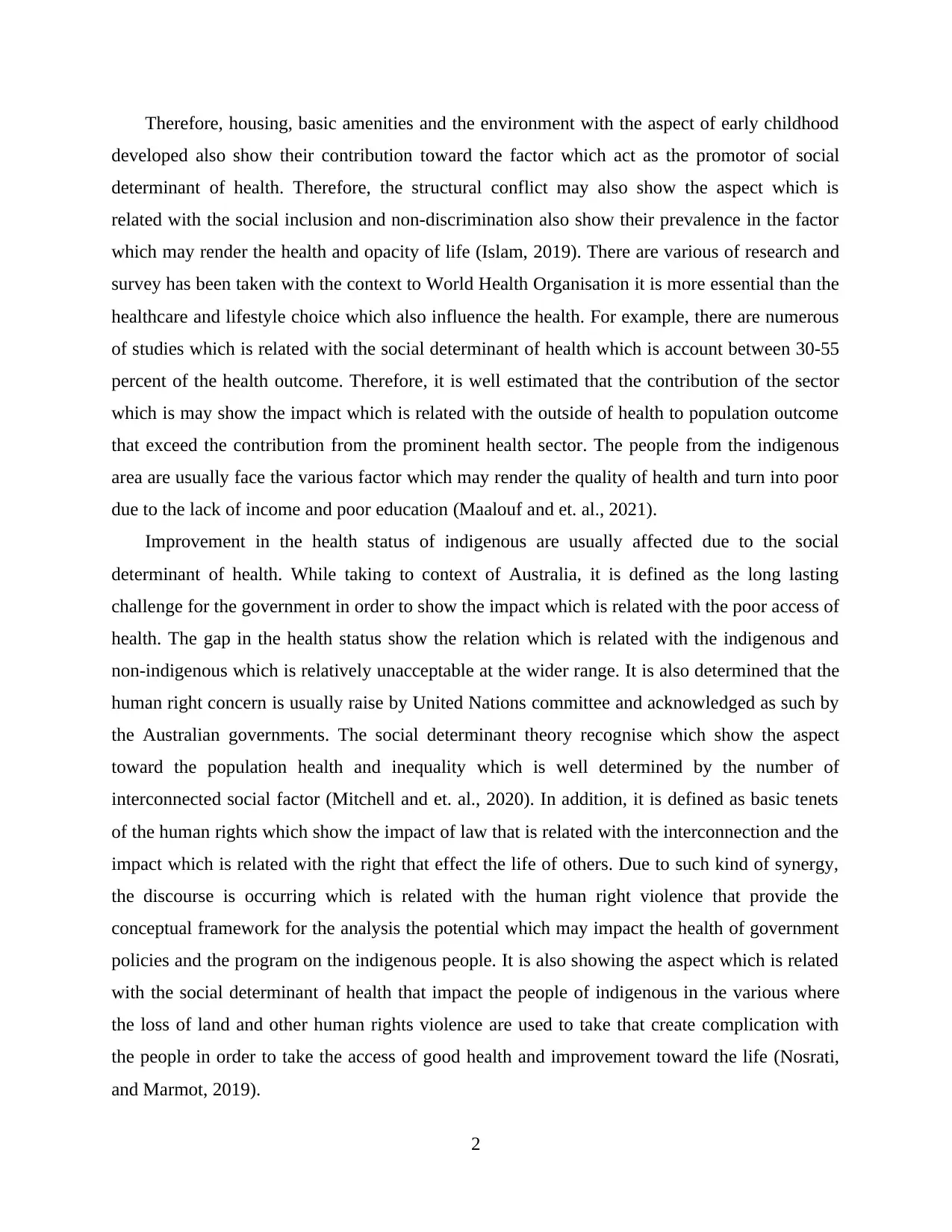
Therefore, housing, basic amenities and the environment with the aspect of early childhood
developed also show their contribution toward the factor which act as the promotor of social
determinant of health. Therefore, the structural conflict may also show the aspect which is
related with the social inclusion and non-discrimination also show their prevalence in the factor
which may render the health and opacity of life (Islam, 2019). There are various of research and
survey has been taken with the context to World Health Organisation it is more essential than the
healthcare and lifestyle choice which also influence the health. For example, there are numerous
of studies which is related with the social determinant of health which is account between 30-55
percent of the health outcome. Therefore, it is well estimated that the contribution of the sector
which is may show the impact which is related with the outside of health to population outcome
that exceed the contribution from the prominent health sector. The people from the indigenous
area are usually face the various factor which may render the quality of health and turn into poor
due to the lack of income and poor education (Maalouf and et. al., 2021).
Improvement in the health status of indigenous are usually affected due to the social
determinant of health. While taking to context of Australia, it is defined as the long lasting
challenge for the government in order to show the impact which is related with the poor access of
health. The gap in the health status show the relation which is related with the indigenous and
non-indigenous which is relatively unacceptable at the wider range. It is also determined that the
human right concern is usually raise by United Nations committee and acknowledged as such by
the Australian governments. The social determinant theory recognise which show the aspect
toward the population health and inequality which is well determined by the number of
interconnected social factor (Mitchell and et. al., 2020). In addition, it is defined as basic tenets
of the human rights which show the impact of law that is related with the interconnection and the
impact which is related with the right that effect the life of others. Due to such kind of synergy,
the discourse is occurring which is related with the human right violence that provide the
conceptual framework for the analysis the potential which may impact the health of government
policies and the program on the indigenous people. It is also showing the aspect which is related
with the social determinant of health that impact the people of indigenous in the various where
the loss of land and other human rights violence are used to take that create complication with
the people in order to take the access of good health and improvement toward the life (Nosrati,
and Marmot, 2019).
2
developed also show their contribution toward the factor which act as the promotor of social
determinant of health. Therefore, the structural conflict may also show the aspect which is
related with the social inclusion and non-discrimination also show their prevalence in the factor
which may render the health and opacity of life (Islam, 2019). There are various of research and
survey has been taken with the context to World Health Organisation it is more essential than the
healthcare and lifestyle choice which also influence the health. For example, there are numerous
of studies which is related with the social determinant of health which is account between 30-55
percent of the health outcome. Therefore, it is well estimated that the contribution of the sector
which is may show the impact which is related with the outside of health to population outcome
that exceed the contribution from the prominent health sector. The people from the indigenous
area are usually face the various factor which may render the quality of health and turn into poor
due to the lack of income and poor education (Maalouf and et. al., 2021).
Improvement in the health status of indigenous are usually affected due to the social
determinant of health. While taking to context of Australia, it is defined as the long lasting
challenge for the government in order to show the impact which is related with the poor access of
health. The gap in the health status show the relation which is related with the indigenous and
non-indigenous which is relatively unacceptable at the wider range. It is also determined that the
human right concern is usually raise by United Nations committee and acknowledged as such by
the Australian governments. The social determinant theory recognise which show the aspect
toward the population health and inequality which is well determined by the number of
interconnected social factor (Mitchell and et. al., 2020). In addition, it is defined as basic tenets
of the human rights which show the impact of law that is related with the interconnection and the
impact which is related with the right that effect the life of others. Due to such kind of synergy,
the discourse is occurring which is related with the human right violence that provide the
conceptual framework for the analysis the potential which may impact the health of government
policies and the program on the indigenous people. It is also showing the aspect which is related
with the social determinant of health that impact the people of indigenous in the various where
the loss of land and other human rights violence are used to take that create complication with
the people in order to take the access of good health and improvement toward the life (Nosrati,
and Marmot, 2019).
2
Paraphrase This Document
Need a fresh take? Get an instant paraphrase of this document with our AI Paraphraser
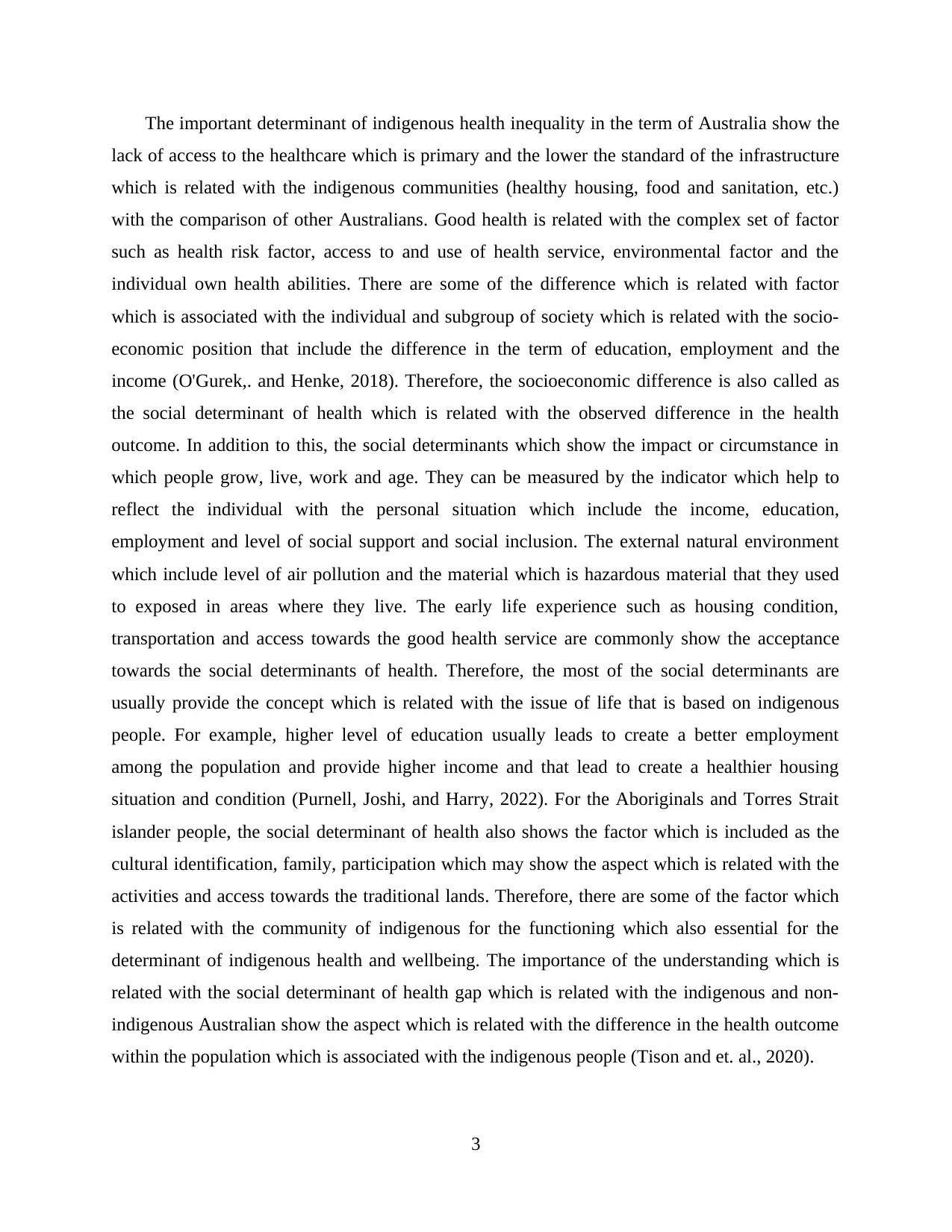
The important determinant of indigenous health inequality in the term of Australia show the
lack of access to the healthcare which is primary and the lower the standard of the infrastructure
which is related with the indigenous communities (healthy housing, food and sanitation, etc.)
with the comparison of other Australians. Good health is related with the complex set of factor
such as health risk factor, access to and use of health service, environmental factor and the
individual own health abilities. There are some of the difference which is related with factor
which is associated with the individual and subgroup of society which is related with the socio-
economic position that include the difference in the term of education, employment and the
income (O'Gurek,. and Henke, 2018). Therefore, the socioeconomic difference is also called as
the social determinant of health which is related with the observed difference in the health
outcome. In addition to this, the social determinants which show the impact or circumstance in
which people grow, live, work and age. They can be measured by the indicator which help to
reflect the individual with the personal situation which include the income, education,
employment and level of social support and social inclusion. The external natural environment
which include level of air pollution and the material which is hazardous material that they used
to exposed in areas where they live. The early life experience such as housing condition,
transportation and access towards the good health service are commonly show the acceptance
towards the social determinants of health. Therefore, the most of the social determinants are
usually provide the concept which is related with the issue of life that is based on indigenous
people. For example, higher level of education usually leads to create a better employment
among the population and provide higher income and that lead to create a healthier housing
situation and condition (Purnell, Joshi, and Harry, 2022). For the Aboriginals and Torres Strait
islander people, the social determinant of health also shows the factor which is included as the
cultural identification, family, participation which may show the aspect which is related with the
activities and access towards the traditional lands. Therefore, there are some of the factor which
is related with the community of indigenous for the functioning which also essential for the
determinant of indigenous health and wellbeing. The importance of the understanding which is
related with the social determinant of health gap which is related with the indigenous and non-
indigenous Australian show the aspect which is related with the difference in the health outcome
within the population which is associated with the indigenous people (Tison and et. al., 2020).
3
lack of access to the healthcare which is primary and the lower the standard of the infrastructure
which is related with the indigenous communities (healthy housing, food and sanitation, etc.)
with the comparison of other Australians. Good health is related with the complex set of factor
such as health risk factor, access to and use of health service, environmental factor and the
individual own health abilities. There are some of the difference which is related with factor
which is associated with the individual and subgroup of society which is related with the socio-
economic position that include the difference in the term of education, employment and the
income (O'Gurek,. and Henke, 2018). Therefore, the socioeconomic difference is also called as
the social determinant of health which is related with the observed difference in the health
outcome. In addition to this, the social determinants which show the impact or circumstance in
which people grow, live, work and age. They can be measured by the indicator which help to
reflect the individual with the personal situation which include the income, education,
employment and level of social support and social inclusion. The external natural environment
which include level of air pollution and the material which is hazardous material that they used
to exposed in areas where they live. The early life experience such as housing condition,
transportation and access towards the good health service are commonly show the acceptance
towards the social determinants of health. Therefore, the most of the social determinants are
usually provide the concept which is related with the issue of life that is based on indigenous
people. For example, higher level of education usually leads to create a better employment
among the population and provide higher income and that lead to create a healthier housing
situation and condition (Purnell, Joshi, and Harry, 2022). For the Aboriginals and Torres Strait
islander people, the social determinant of health also shows the factor which is included as the
cultural identification, family, participation which may show the aspect which is related with the
activities and access towards the traditional lands. Therefore, there are some of the factor which
is related with the community of indigenous for the functioning which also essential for the
determinant of indigenous health and wellbeing. The importance of the understanding which is
related with the social determinant of health gap which is related with the indigenous and non-
indigenous Australian show the aspect which is related with the difference in the health outcome
within the population which is associated with the indigenous people (Tison and et. al., 2020).
3
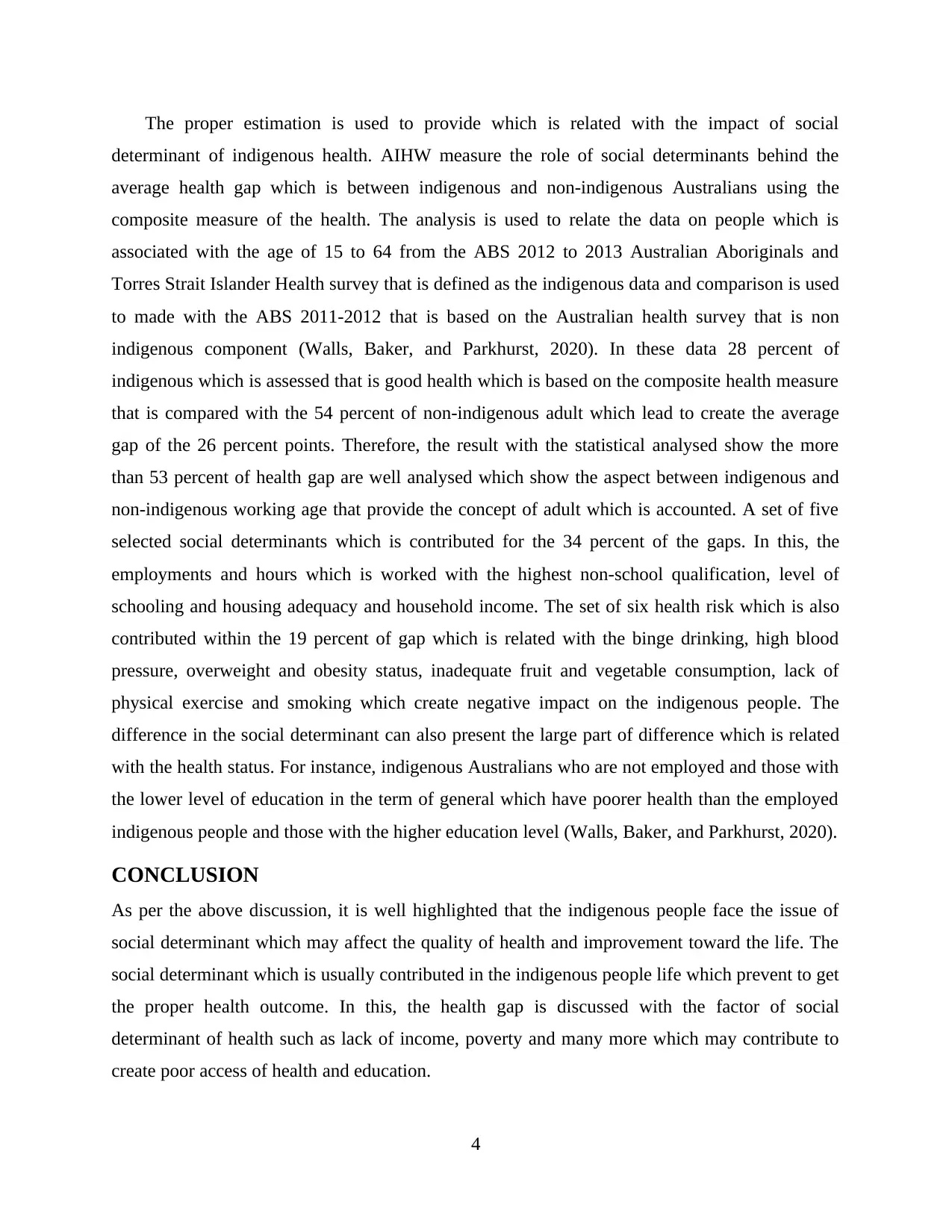
The proper estimation is used to provide which is related with the impact of social
determinant of indigenous health. AIHW measure the role of social determinants behind the
average health gap which is between indigenous and non-indigenous Australians using the
composite measure of the health. The analysis is used to relate the data on people which is
associated with the age of 15 to 64 from the ABS 2012 to 2013 Australian Aboriginals and
Torres Strait Islander Health survey that is defined as the indigenous data and comparison is used
to made with the ABS 2011-2012 that is based on the Australian health survey that is non
indigenous component (Walls, Baker, and Parkhurst, 2020). In these data 28 percent of
indigenous which is assessed that is good health which is based on the composite health measure
that is compared with the 54 percent of non-indigenous adult which lead to create the average
gap of the 26 percent points. Therefore, the result with the statistical analysed show the more
than 53 percent of health gap are well analysed which show the aspect between indigenous and
non-indigenous working age that provide the concept of adult which is accounted. A set of five
selected social determinants which is contributed for the 34 percent of the gaps. In this, the
employments and hours which is worked with the highest non-school qualification, level of
schooling and housing adequacy and household income. The set of six health risk which is also
contributed within the 19 percent of gap which is related with the binge drinking, high blood
pressure, overweight and obesity status, inadequate fruit and vegetable consumption, lack of
physical exercise and smoking which create negative impact on the indigenous people. The
difference in the social determinant can also present the large part of difference which is related
with the health status. For instance, indigenous Australians who are not employed and those with
the lower level of education in the term of general which have poorer health than the employed
indigenous people and those with the higher education level (Walls, Baker, and Parkhurst, 2020).
CONCLUSION
As per the above discussion, it is well highlighted that the indigenous people face the issue of
social determinant which may affect the quality of health and improvement toward the life. The
social determinant which is usually contributed in the indigenous people life which prevent to get
the proper health outcome. In this, the health gap is discussed with the factor of social
determinant of health such as lack of income, poverty and many more which may contribute to
create poor access of health and education.
4
determinant of indigenous health. AIHW measure the role of social determinants behind the
average health gap which is between indigenous and non-indigenous Australians using the
composite measure of the health. The analysis is used to relate the data on people which is
associated with the age of 15 to 64 from the ABS 2012 to 2013 Australian Aboriginals and
Torres Strait Islander Health survey that is defined as the indigenous data and comparison is used
to made with the ABS 2011-2012 that is based on the Australian health survey that is non
indigenous component (Walls, Baker, and Parkhurst, 2020). In these data 28 percent of
indigenous which is assessed that is good health which is based on the composite health measure
that is compared with the 54 percent of non-indigenous adult which lead to create the average
gap of the 26 percent points. Therefore, the result with the statistical analysed show the more
than 53 percent of health gap are well analysed which show the aspect between indigenous and
non-indigenous working age that provide the concept of adult which is accounted. A set of five
selected social determinants which is contributed for the 34 percent of the gaps. In this, the
employments and hours which is worked with the highest non-school qualification, level of
schooling and housing adequacy and household income. The set of six health risk which is also
contributed within the 19 percent of gap which is related with the binge drinking, high blood
pressure, overweight and obesity status, inadequate fruit and vegetable consumption, lack of
physical exercise and smoking which create negative impact on the indigenous people. The
difference in the social determinant can also present the large part of difference which is related
with the health status. For instance, indigenous Australians who are not employed and those with
the lower level of education in the term of general which have poorer health than the employed
indigenous people and those with the higher education level (Walls, Baker, and Parkhurst, 2020).
CONCLUSION
As per the above discussion, it is well highlighted that the indigenous people face the issue of
social determinant which may affect the quality of health and improvement toward the life. The
social determinant which is usually contributed in the indigenous people life which prevent to get
the proper health outcome. In this, the health gap is discussed with the factor of social
determinant of health such as lack of income, poverty and many more which may contribute to
create poor access of health and education.
4
⊘ This is a preview!⊘
Do you want full access?
Subscribe today to unlock all pages.

Trusted by 1+ million students worldwide
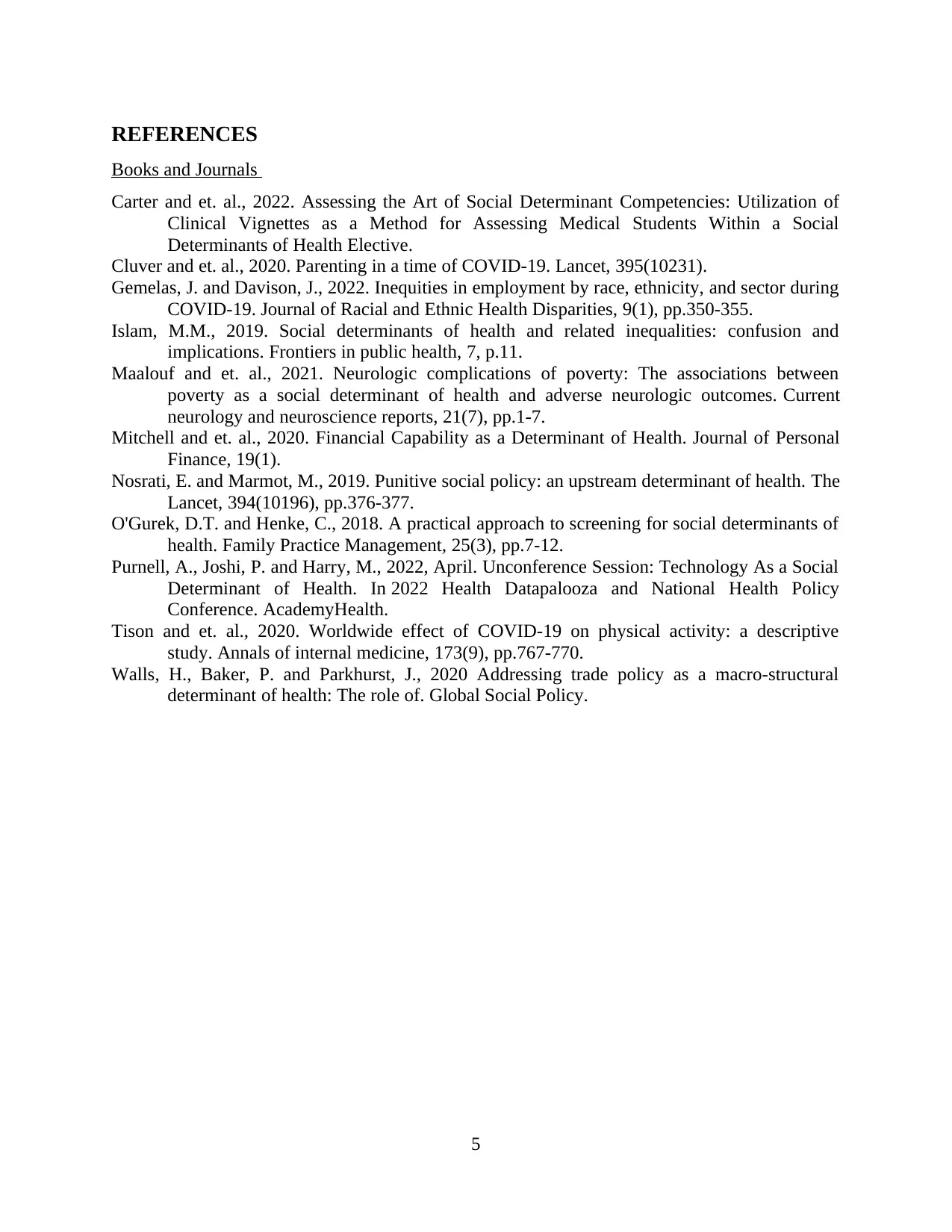
REFERENCES
Books and Journals
Carter and et. al., 2022. Assessing the Art of Social Determinant Competencies: Utilization of
Clinical Vignettes as a Method for Assessing Medical Students Within a Social
Determinants of Health Elective.
Cluver and et. al., 2020. Parenting in a time of COVID-19. Lancet, 395(10231).
Gemelas, J. and Davison, J., 2022. Inequities in employment by race, ethnicity, and sector during
COVID-19. Journal of Racial and Ethnic Health Disparities, 9(1), pp.350-355.
Islam, M.M., 2019. Social determinants of health and related inequalities: confusion and
implications. Frontiers in public health, 7, p.11.
Maalouf and et. al., 2021. Neurologic complications of poverty: The associations between
poverty as a social determinant of health and adverse neurologic outcomes. Current
neurology and neuroscience reports, 21(7), pp.1-7.
Mitchell and et. al., 2020. Financial Capability as a Determinant of Health. Journal of Personal
Finance, 19(1).
Nosrati, E. and Marmot, M., 2019. Punitive social policy: an upstream determinant of health. The
Lancet, 394(10196), pp.376-377.
O'Gurek, D.T. and Henke, C., 2018. A practical approach to screening for social determinants of
health. Family Practice Management, 25(3), pp.7-12.
Purnell, A., Joshi, P. and Harry, M., 2022, April. Unconference Session: Technology As a Social
Determinant of Health. In 2022 Health Datapalooza and National Health Policy
Conference. AcademyHealth.
Tison and et. al., 2020. Worldwide effect of COVID-19 on physical activity: a descriptive
study. Annals of internal medicine, 173(9), pp.767-770.
Walls, H., Baker, P. and Parkhurst, J., 2020 Addressing trade policy as a macro-structural
determinant of health: The role of. Global Social Policy.
5
Books and Journals
Carter and et. al., 2022. Assessing the Art of Social Determinant Competencies: Utilization of
Clinical Vignettes as a Method for Assessing Medical Students Within a Social
Determinants of Health Elective.
Cluver and et. al., 2020. Parenting in a time of COVID-19. Lancet, 395(10231).
Gemelas, J. and Davison, J., 2022. Inequities in employment by race, ethnicity, and sector during
COVID-19. Journal of Racial and Ethnic Health Disparities, 9(1), pp.350-355.
Islam, M.M., 2019. Social determinants of health and related inequalities: confusion and
implications. Frontiers in public health, 7, p.11.
Maalouf and et. al., 2021. Neurologic complications of poverty: The associations between
poverty as a social determinant of health and adverse neurologic outcomes. Current
neurology and neuroscience reports, 21(7), pp.1-7.
Mitchell and et. al., 2020. Financial Capability as a Determinant of Health. Journal of Personal
Finance, 19(1).
Nosrati, E. and Marmot, M., 2019. Punitive social policy: an upstream determinant of health. The
Lancet, 394(10196), pp.376-377.
O'Gurek, D.T. and Henke, C., 2018. A practical approach to screening for social determinants of
health. Family Practice Management, 25(3), pp.7-12.
Purnell, A., Joshi, P. and Harry, M., 2022, April. Unconference Session: Technology As a Social
Determinant of Health. In 2022 Health Datapalooza and National Health Policy
Conference. AcademyHealth.
Tison and et. al., 2020. Worldwide effect of COVID-19 on physical activity: a descriptive
study. Annals of internal medicine, 173(9), pp.767-770.
Walls, H., Baker, P. and Parkhurst, J., 2020 Addressing trade policy as a macro-structural
determinant of health: The role of. Global Social Policy.
5
1 out of 7
Related Documents
Your All-in-One AI-Powered Toolkit for Academic Success.
+13062052269
info@desklib.com
Available 24*7 on WhatsApp / Email
![[object Object]](/_next/static/media/star-bottom.7253800d.svg)
Unlock your academic potential
Copyright © 2020–2025 A2Z Services. All Rights Reserved. Developed and managed by ZUCOL.





